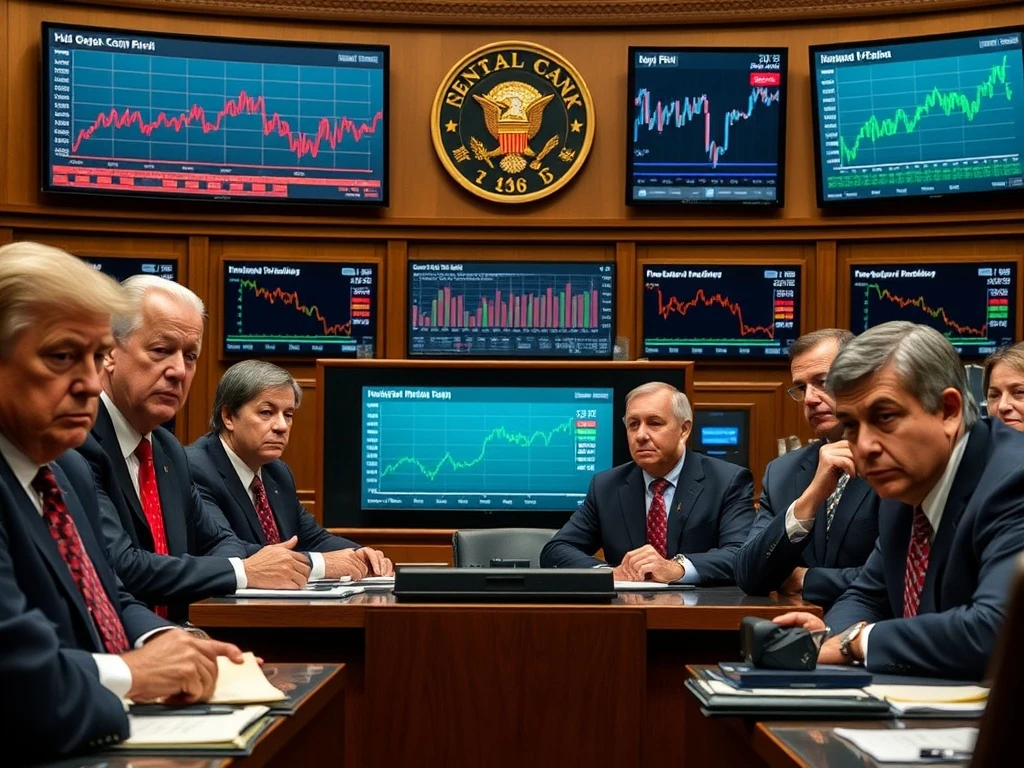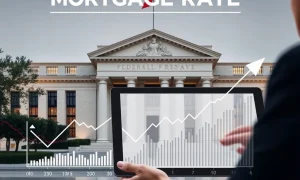The financial markets often anticipate shifts in monetary policy. Recently, however, a divergence has emerged. While many investors hoped for a swift easing of conditions, some prominent Federal Reserve officials express caution. They are notably cool to the idea of a **Fed rate cut** occurring as early as September. This stance introduces significant uncertainty into economic forecasts and market strategies.
Understanding this cautious approach is crucial. It directly impacts various sectors of the economy. From borrowing costs to investment returns, the Fed’s decisions ripple widely. Therefore, grasping the reasons behind this hesitancy becomes paramount for businesses and individuals alike. This article explores the specific concerns voiced by these officials. It also delves into the economic indicators shaping their perspective on a potential **Fed rate cut**.
Understanding the Stance on a Fed Rate Cut
Several Federal Reserve policymakers have voiced skepticism regarding an early interest rate reduction. Their primary concern remains inflation. They believe inflationary pressures have not yet subsided enough to warrant a significant policy shift. These officials typically emphasize a data-dependent approach. They insist on seeing clear and sustained evidence that inflation is moving towards the Fed’s 2% target.
For instance, one official might highlight the resilience of the labor market. A strong job market can sustain consumer spending. This, in turn, can keep prices elevated. Another policymaker might point to recent services inflation. This area has proven particularly sticky. Consequently, a premature **Fed rate cut** could reignite inflationary pressures. This risk is something they wish to avoid at all costs. They remember the challenges of controlling inflation once it gains momentum. Therefore, patience is key to their strategy.
Their collective message is clear: the job of bringing inflation down is not yet complete. They advocate for maintaining restrictive monetary policy for a longer duration. This ‘higher for longer’ narrative has gained traction among certain members. It suggests that while inflation has fallen from its peak, the final stretch might be the most challenging. Thus, any talk of a September **Fed rate cut** seems premature to them.
The Economic Data Fueling Caution for a Fed Rate Cut
Federal Reserve officials base their decisions on a wide array of economic data. Recent reports, while showing progress, also present a mixed picture. This complexity fuels the cautious stance on a **Fed rate cut**. Key indicators they closely monitor include:
- Inflation Measures: The Consumer Price Index (CPI) and Personal Consumption Expenditures (PCE) price index are vital. While headline inflation has decreased, core inflation (excluding volatile food and energy prices) remains a concern. Services inflation, especially, has shown stubborn persistence.
- Labor Market Strength: The unemployment rate remains low. Job growth continues to be robust. Wage growth, while moderating, is still strong enough to potentially fuel demand-driven inflation. A tight labor market often translates to higher wages. This can push up business costs. These costs are then passed on to consumers.
- Consumer Spending: Resilient consumer spending indicates underlying economic strength. This strength suggests the economy can withstand higher interest rates for longer. It reduces the urgency for a **Fed rate cut**.
- Economic Growth: Gross Domestic Product (GDP) figures have shown surprising resilience. This sustained growth provides the Fed with flexibility. They do not feel pressured to cut rates to avoid a recession.
These data points collectively paint a picture of an economy that is performing well. It is growing, and the labor market is strong. Inflation is cooling, but perhaps not quickly enough for some officials. Therefore, the argument for an immediate **Fed rate cut** weakens. They prefer to wait for more definitive evidence of disinflation. This ensures their actions are well-supported by economic realities.
Market Expectations Versus Fed Reality for a Fed Rate Cut
Financial markets often react swiftly to economic news and central bank communications. Investors frequently price in future interest rate changes well in advance. However, a noticeable gap has emerged between market expectations and the Federal Reserve’s communicated intentions regarding a **Fed rate cut**. Markets have, at times, anticipated several rate cuts within a year. This contrasts sharply with the Fed’s more conservative outlook.
Why does this divergence occur? Firstly, markets tend to be forward-looking and often react to minor shifts in data. They may interpret a single softer inflation report as a sign of an imminent pivot. Secondly, investors might overestimate the Fed’s willingness to prioritize growth over inflation control. The Fed, however, remains steadfast in its commitment to price stability. They have learned from past experiences. Premature easing can lead to a resurgence of inflation. Therefore, they proceed with caution.
This gap creates volatility. When Fed officials push back against aggressive rate cut expectations, markets often experience pullbacks. This phenomenon highlights the importance of listening to direct communication from policymakers. While economic models are useful, the human element in decision-making remains critical. The Fed aims for a soft landing. They want to bring inflation down without causing a deep recession. This delicate balancing act requires patience. It also means resisting pressure for an early **Fed rate cut** when the data does not fully support it.
Implications for Investors and the Economy Regarding a Fed Rate Cut
The Federal Reserve’s cautious stance on a **Fed rate cut** has broad implications. Investors must adjust their strategies accordingly. Different sectors of the economy will experience varying impacts. Understanding these effects is vital for sound financial planning.
For example, a ‘higher for longer’ interest rate environment affects several key areas:
- Equity Markets: Growth stocks, particularly in technology, can face headwinds. Higher interest rates increase the cost of borrowing for companies. This can reduce future earnings potential. Conversely, value stocks or dividend-paying companies might become more attractive. Sectors like financials may benefit from wider net interest margins.
- Bond Markets: Bond yields tend to remain elevated. This makes fixed-income investments more appealing. However, existing bond portfolios might see their values decline if rates continue to rise. Investors may favor shorter-duration bonds to minimize interest rate risk.
- Housing Market: Mortgage rates are directly tied to broader interest rate trends. A sustained period of high rates can cool the housing market. Affordability becomes a significant challenge for potential homebuyers. This can lead to reduced sales and slower price appreciation.
- Consumer Lending: Credit card interest rates and auto loan rates will remain high. This increases the cost of borrowing for consumers. It could potentially slow down consumer spending. Businesses also face higher borrowing costs for expansion.
Ultimately, the absence of an immediate **Fed rate cut** signals the Fed’s commitment. They prioritize long-term price stability. This might mean a slower economic growth trajectory in the short term. However, it aims for a more sustainable expansion in the future. Businesses and individuals should prepare for a period of elevated interest rates. This requires careful budgeting and investment choices.
The Path Forward for a Potential Fed Rate Cut
Despite the current skepticism, a **Fed rate cut** remains a possibility in the future. The timing, however, depends entirely on incoming economic data. Federal Reserve officials are explicitly data-dependent. They continue to monitor a range of indicators. These include inflation trends, labor market dynamics, and global economic developments. Their decisions will reflect these evolving conditions.
Policymakers will look for clear signs of disinflation. They want to see inflation sustainably moving towards the 2% target. This means not just a few good reports, but a consistent pattern. Furthermore, any significant weakening in the labor market could prompt a policy shift. A sudden rise in unemployment or a sharp decline in job openings would be closely watched. Such a scenario might signal an increased risk of recession. In that case, a **Fed rate cut** could become more urgent.
Global economic conditions also play a role. Slowdowns in major economies or geopolitical events can impact U.S. economic prospects. The Fed considers these external factors when assessing risks to its dual mandate of maximum employment and price stability. Therefore, the path to a **Fed rate cut** is not predetermined. It will be a measured, cautious process. It will involve careful analysis of all available information. Market participants should remain agile. They must adapt to new data as it emerges. This iterative approach ensures policy remains appropriate for the economic environment.
In conclusion, the current cautious stance by some Federal Reserve officials reflects a commitment to fighting inflation. They prioritize sustained price stability over early rate reductions. While market participants may hope for a September **Fed rate cut**, the Fed’s message is clear: data will drive their decisions. Patience and vigilance remain central to their strategy. The economic landscape will dictate the timing of any future policy easing.
Frequently Asked Questions (FAQs)
Q1: Why are some Fed officials against an early Fed rate cut?
Some Fed officials are against an early **Fed rate cut** primarily due to persistent inflation concerns. They believe inflation has not yet consistently reached the Fed’s 2% target. They also point to a robust labor market and resilient consumer spending, which reduce the urgency for immediate easing.
Q2: What economic data points influence the Fed’s decision on a Fed rate cut?
The Federal Reserve closely monitors several key economic data points. These include inflation measures like CPI and PCE, labor market indicators such as the unemployment rate and job growth, consumer spending data, and overall GDP growth. These figures provide a comprehensive view of economic health.
Q3: How does the Fed’s cautious stance impact financial markets?
A cautious stance on a **Fed rate cut** can lead to market volatility. It may cause pullbacks in equity markets, particularly for growth stocks. Bond yields tend to remain elevated. Mortgage rates also stay higher. This impacts borrowing costs for businesses and consumers alike.
Q4: What does ‘higher for longer’ mean in the context of Fed policy?
‘Higher for longer’ refers to the Federal Reserve’s strategy of maintaining elevated interest rates for an extended period. This approach aims to ensure inflation is fully brought under control. It suggests that rates will not be cut until there is clear, sustained evidence of disinflation, even if it means slower economic growth.
Q5: When might a Fed rate cut become more likely?
A **Fed rate cut** would likely become more probable if inflation shows consistent and significant declines towards the 2% target. Additionally, a notable weakening in the labor market, such as a sharp rise in unemployment, or a severe economic downturn, could also prompt the Fed to consider cutting rates.
Q6: How do global economic conditions affect the Fed’s decisions on a Fed rate cut?
Global economic conditions can influence the Fed’s policy decisions. Slowdowns in major international economies, geopolitical events, or shifts in global supply chains can impact the U.S. economy. The Fed considers these external factors when assessing risks to inflation and employment, which in turn affects their stance on a **Fed rate cut**.








